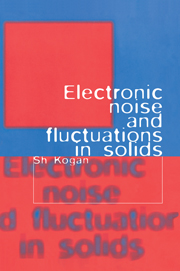Book contents
- Frontmatter
- Contents
- Preface
- Abbreviations
- 1 Introduction: Some basic concepts of the theory of random processes
- 2 Fluctuation–dissipation relations
- 3 Fluctuations in nonequilibrium gases
- 4 Generation–recombination noise
- 5 Noise in quantum ballistic systems
- 6 Resistance noise in metals
- 7 Noise in strongly disordered conductors
- 8 1/f noise and random telegraph noise
- 9 Noise in superconductors
- References
- Subject index
9 - Noise in superconductors
Published online by Cambridge University Press: 17 March 2010
- Frontmatter
- Contents
- Preface
- Abbreviations
- 1 Introduction: Some basic concepts of the theory of random processes
- 2 Fluctuation–dissipation relations
- 3 Fluctuations in nonequilibrium gases
- 4 Generation–recombination noise
- 5 Noise in quantum ballistic systems
- 6 Resistance noise in metals
- 7 Noise in strongly disordered conductors
- 8 1/f noise and random telegraph noise
- 9 Noise in superconductors
- References
- Subject index
Summary
One more, the final record, and my annals
Are ended, and fulfilled the duty laid
By God on me, a sinner.
Alexander Pushkin, ‘Boris Godunov’.Many metals and alloys become superconductive at low temperatures owing to mutual attractive interaction between electrons and to the sharpness of the Fermi distribution edge at the Fermi energy Ef. Qualitatively, the electron system in the superconductive state may be viewed as being composed of electrons bound in electron pairs (Cooper pairs) each of which contains two electrons with opposite momenta and spins. The dimensions of the pairs are greater than the mean interelectron distance, i.e., the pairs strongly overlap. This state of paired electrons is called ‘condensate’. It is superconductive, that is, current flows without any resistance. At temperatures T lower than the critical temperature TC, the free energy of the condensate is lower than that of an unpaired electron gas of the same density. Therefore, at T =Tc the metal, undergoes a phase transition into the superconductive state.
The properties of a superconductor are determined by the binding energy of electron pairs in the condensate, 2Δ. This quantity is called also the superconductive energy gap, because just this energy is required to break an electron pair in the condensate and create two quasi-particles that are able, like electrons in a normal metal, to dissipate the current. The energy Δ decreases with increasing temperature T and becomes zero at T = Tc.
- Type
- Chapter
- Information
- Electronic Noise and Fluctuations in Solids , pp. 287 - 325Publisher: Cambridge University PressPrint publication year: 1996

